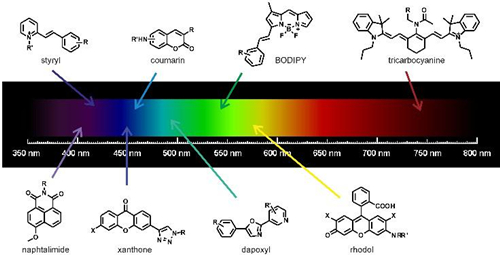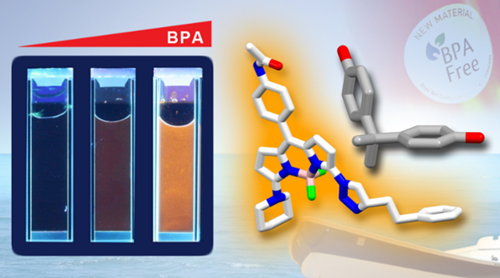Recently, some research progress on detecting environmental pollutants and biological macromolecules were finished by the cooperation of Dr. Liyun Zhang of Hefei Institutes of Physical Science and ProfessorChang Young tae, who is from National University of Singapore. Their studies demonstrated that DOFLA offered a novel method for environment science, life science and their related fields. Now, the long-term cooperation has been built between Dr. Liyun Zhang and Professor Chang Young Tae. They are performing a new work plan on analysis the toxic materials in water environmental and developing the novel specific DNA G-Quadruplex fluorescent sensors.
Diversity-Oriented Fluorescent Libraries make use of combinatorial chemistry to generate libraries of fluorescent molecules. Now DOFL composes of more than 10 000 intrinsically fluorescent small molecules, which has almost covered the whole spectrum (Figure 1). Comparing with the target-oriented approach offers a quick and efficient way to discover novel fluorescent sensors. DOFLA displays some advantages: (i) they have a broad scope of applications and are unbiased (ii) the newly discovered receptors do not need an additional reporter.
Dr. Zhang Liyun started to cooperate with professor Chang Young Tea, the inventor of DOFLA, to develop novel fluorescent sensors by diversity-oriented fluorescent library approach in National University of Singapore since 2012. A selective sensor for bisphenol Awas discovered.
Bisphenol A (BPA), an endocrine disruptor and a widespread pollutant originating from polycarbonate plastics and epoxy resins which is well documented to cause negative health effects in human and animals. To assess the risk and ensure environmental safety and health, a simple method to selectively and sensitively detect BPA is critical. A turn-on BODIPY compound, named Bisphenol Orange (BPO), which could detect BPA in a wide variety of real water environments including sea water, drain water and drinking water, was reported in Analytica Chimica Acta (Figure 2). In addition, another sensor specific to caffeine was reported in Scientific Reports by them. Caffeine has attracted abundant attention due to its extensive existence in beverages and medicines. However, to detect it sensitively and conveniently remains a challenge, especially in resource-limited regions. They reported a novel aqueous phase fluorescent caffeine sensor named Caffeine Orange which exhibits 250-fold fluorescence enhancement upon caffeine activation and high selectivity. Owing to unique features of Caffeine Orange, naked-eye sensing of various caffeine concentrations is possible.
Owning to the advantage of DOFLA, they also performed work for DNA G-quadruplexes sensor. The DNA G-quadruplexes constitute a class of non-canonical nucleic acid structures characterized by guanine-rich sequences that fold into polymorphic stacked tetrads. These structures are increasingly recognized as potential therapeutic targets in anticancer and anti-HIV drug development. Moreover, they can be artificially engineered for drug delivery and nanomaterials. G-quadruplexes are structurally diverse and a simple method that can sensitively detect and distinguish the different G-quadruplex topologies remains scarce. To fulfil this goal, they developed a novel BODIPY-based fluorescent sensor (GQR) that can sensitively and specifically probe a specific subset of parallel stranded G-quadruplexes that possess an exposed core end and four medium groves (Scientific Reports , Figure 3). The sensing mechanism demonstrated that GQR performed a specific disaggregation-induced emission (DIE) property. Considering the common phenomenon of DIE, a review titled "the role of “disaggregation” in optical probe development" was published by them in Chemical Society Reviews.

Figure 1. General structures of conventional fluorescent scaffolds for diversity-oriented libraries. Arrows point at the approximate fluorescence emission wavelengths of the fluorophores.

Figure 2. “Orange alert”: A fluorescent detector for bisphenol A in water environments

Figure 3 Selectivity of GQR to oligonucleotides. GQR can sensitively and specifically probe a specific parallel stranded G-quadruplexes that possess an exposed core end and four medium groves
Analytica Chimica Acta:http://www.sciencedirect.com/science/article/pii/S0003267014001032
Scientific Reports:http://www.nature.com/srep/2013/130723/srep02255/full/srep02255.html
Scientific Reports: http://www.nature.com/srep/2014/140120/srep03776/full/srep03776.html
Chemical Society Reviews:http://pubs.rsc.org/en/content/articlelanding/2014/cs/c3cs60368g#!divAbstract